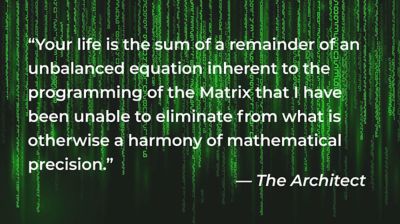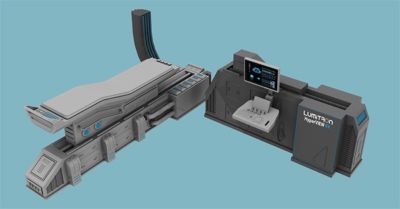-
-
Access Free Student Software
Ansys empowers the next generation of engineers
Students get free access to world-class simulation software.
-
Connect with Ansys Now!
Design your future
Connect with Ansys to explore how simulation can power your next breakthrough.
Countries & Regions
Free Trials
Products & Services
Learn
About
Back
Products & Services
Back
Learn
Ansys empowers the next generation of engineers
Students get free access to world-class simulation software.
Back
About
Design your future
Connect with Ansys to explore how simulation can power your next breakthrough.
Free Trials
ANSYS BLOG
December 15, 2021
Open Your Mind with Simulation

What if we are completely unaware of a more authentic reality that exists beyond what we can perceive? After all, once you’ve taught someone to think inside a box — or in this case, inside a simulated world — everything within that box becomes believable, possible, and real. It becomes your reality. To the contrary, the unknown world outside of the box (the Matrix) becomes unbelievable, impossible, and unreal. The box represents your rubicon: an imaginary line dividing what you believe is possible from what you believe is impossible.
We can’t say that any computer programmers at Ansys have been offered a life-changing choice between a red or blue pill, but we do know that simulation enables you to see things that others cannot see, predict what will happen if things change, and do things that you might not have thought possible. It enables you to expand your rubicon to accept more possibilities.

Tuning an Energy Beam with Simulation
For example, humans can only see visible light, which is just 0.0035% of the electromagnetic spectrum. This means we can’t see more than 99% of reality, essentially spending our whole lives surrounded by an invisible world. But is that world any less real just because we can’t see it? In engineering science, if you want the truth, you must seek it out in seemingly imperceptible ways. And more often than not, your discoveries are predicated on simulation.

The Lumitron X-ray design improvements could pave the way for combining medical diagnosis and therapy.
One such discovery comes from Lumitron Technologies Inc., which is using Ansys HFSS in tandem with Ansys Fluent to develop new X-ray technology that can image and simultaneously treat a cancerous tumor in one clinical visit. The technology combines accelerators with lasers to create a higher-energy, higher-resolution X-ray beam that could be used simultaneously for imaging and treatment. Tuning to a narrow range of energies with a small source size resulted in greater contrast, higher-resolution imaging, and enabled novel treatment methods for radiosurgery.
“We are very devoted to imaging, diagnostics, and therapy,” says Yoonwoo Hwang, an accelerator physicist at Lumitron who started working on the new X-ray technology as part of his Ph.D. research project while at the University of California, Irvine. “The ability to do these things with one instrument while enhancing the contrast and delivering a lot lower X-ray dose to the patient — that is unique. And Ansys played a big role in making this research and development possible.”
Designing a Solar Cruiser to Drive on Sunshine
Another example of expanding possibilities by visualizing what cannot be seen comes from engineers at Lightyear, an automotive company in Helmond, the Netherlands, who are reimagining solar power to produce the Lightyear One solar car. The effort required Ansys Mechanical, Fluent, and HFSS to design the structural, aerodynamic, electromagnetic, and thermal properties of the five-seat vehicle. Their design includes a roof made of solar panels that can recharge vehicle batteries while driving. The sun does all the work, efficiently topping off the batteries while you’re on the road. For maximum range and efficiency, the entire vehicle was designed with a unique chassis of lightweight aluminum and carbon fiber, powered by four in-wheel motors, and topped by the solar roof.
)
Lightyear One employs solar cells that stretch from the top of the windshield to back of the trunk.
This sustainable mode of transportation can travel up to 450 miles (725 km) on a single charge. And for every hour you drive in the sunshine, the solar cells, which stretch from the top of the windshield all the way back to the trunk, can add up to 7.5 miles (12 km) for every hour spent on the road. Achieving their targeted efficiency required virtual testing using simulation to show maximum deformation (displacement) of various mechanical aspects of the vehicle using computer-generated models. Testing also helped Lightyear design lightweight, incredibly robust solar panels able to withstand bumps in the road that can also function if part of a panel sustains damage.
What Happens When Neo Takes a Punch?
In a traditional medical setting, clinicians struggle to see and accurately measure damage caused by head impacts and concussions using magnetic resonance images (MRIs), computed tomography (CT) scans, and blood tests. Dr. Michael Power, head of clinical care at Beaumont Hospital in Dublin, Ireland, working through Ansys’ Channel Partner CADFEM, is combining engineering simulation and clinical expertise to research the mechanics of a concussion. Working together, CADFEM Ireland and the Institute of Technology Tallaght took a completely new approach, using Ansys LS-DYNA simulations and additional technical support to better quantify head impacts.
The team also used research from Dr. Matthew Campbell’s Genetics Department at Trinity College, which involved the analysis of contrast-enhanced MRI images to understand blood-brain barrier changes of mixed martial arts (MMA) fighters before and after a fight. The sport provided researchers with significant head acceleration data necessary to study head movement following impact. All data was collected through a mouthguard device equipped to record the linear acceleration and angular velocity of impacts. It was then fed into a digital version of a human model developed by the Global Human Body Models Consortium (GHBMC) that was reduced to isolate the head and neck areas to focus on the head’s center of gravity.
Combining the simulation strain data, MRI data, and medical screenings gave researchers a more complete picture of the brain changes that occur after severe head impacts like concussions. With simulation, researchers could better determine the magnitude of the brain strains and get detailed insights on the mechanism of impact behind concussions.
)
Brain strain of an uninjured MMA fighter showing the sagittal and transverse sections.
)
Brain strain of concussed MMA fighter showing the sagittal and transverse sections.
Unlike the Matrix, Ansys simulations are fundamentally created to clarify, rather than obfuscate, the real world. The values for variables involved in a simulation come from real-world observations, with the potential to take them in new directions. Simulations enable exploration, testing, and validating of innovations, speeding product development and time to market through rapid test iterations. These computer-based models or systems are made up of mathematical solvers with the capability to rapidly run equations to solve a variety of complex problems. Simulation can easily solve for increasing complexity through test interactions between mechanical, electronic, and embedded systems to determine product behavior, which helps you comprehend and innovate beyond what you can physically see.
In The Matrix, nothing is what it appears to be. If you want the truth — the real truth — you have to look for it in places that most people don’t. Simulation enables you to explore those places.